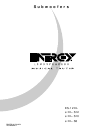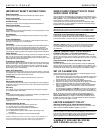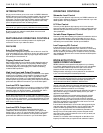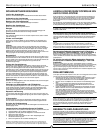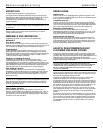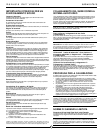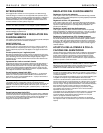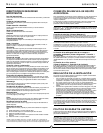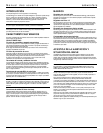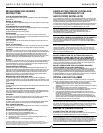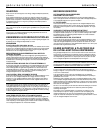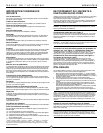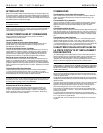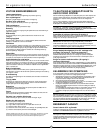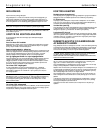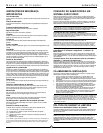
INTRODUCTION
We are proud to welcome you as a new owner of a ENERGY Subwoofer.
ENERGY subwoofers are the result of extensive research into accurate bass
reproduction and represent the leading edge in subwoofer design and
performance. The finest components and cabinet materials combined with
sophisticated manufacturing and quality control procedures ensure many
years of exceptional performance and listening pleasure.
Please take time to read all of the instructions contained in this manual to
make certain your system is properly installed and functioning correctly.
Be sure to unpack your subwoofer carefully. Retain the carton and all
packing material for future use.
FEATURES AND OPERATING CONTROLS
All operating controls are conveniently located on the amplifier panel
mounted on the rear of your subwoofer cabinet.
FEATURES
Auto-On/Auto-Off Circuit
Your subwoofer is equipped with a special “Auto-on/Auto-off”circuit.This
circuit automatically turns your subwoofer on as soon as it senses a program
signal. At a predetermined time after the program signal ends, this circuit
automatically turns the subwoofer off.
Clipping Protection Circuit
Many powered subwoofers on the market produce distorted sounds as a
result of clipping at high input levels. The proprietary ENERGY Clipping
Protection Circuit (CPC) continuously senses the input signal level and
automatically adjusts to prevent clipping of the waveform, maintaining
undistorted bass reproduction.
High Level Input and Output Terminals
The High Level inputs allow you to connect your subwoofer to the speaker
outputs of any A/V Receiver or power amplifier. The signal from the High
Level output terminals passes through a built-in High Pass Filter. When
these terminals are connected to your main/satellite speakers, the result is
increased dynamic range and power handling, which improves overall system
performance. See “Subwoofer Connection to your Audio/Video System”.
Low-Level RCA Input Jacks
The two RCA Input jacks allow you to connect your subwoofer to EITHER:
1) The subwoofer mono output of an A/V Receiver/Processor OR 2) The
subwoofer output of an External Crossover 3) Model ES-12XL ONLY -
The left and right pre-out jacks of an A/V Receiver/Processor
NOTE: When using the External Crossover Input, the subwoofer Level
Control and LP Filter Control on the subwoofer’s rear panel are bypassed
and have no effect on the subwoofer. In this mode, adjustments are made
using the controls provided on the optional ENERGY EAC Crossover or
other External Crossovers.
Low-Level RCA Output Jacks
The output signal from these jacks is actively filtered below 80 Hz
(18dB/octave). When these jacks are connected to your system’s main
amplifier input (or "main-in” for many Audio/Video receivers). The result is
increased dynamic range, lower distortion, and improved overall system
performance. See “Subwoofer Connection to your Audio/Video System”.
OPERATING CONTROLS
Subwoofer Level Control
This rotary control adjusts the output level of your ENERGY subwoofer and
should be used to balance the level of the subwoofer with that of your main
satellite speakers. See “Set-up Calibration”.
LP Filter Control
This rotary control adjusts the high frequency roll-off of the subwoofer.
Continuously variable from 50Hz to 100Hz, it is used to precisely match the
subwoofer bass reproduction with that of your main/satellite speakers. See
“Set-up Calibration”.
Variable Phase Alignment Control
This rotary control allows matching of the phase of the subwoofer with that
of your main/satellite speakers. Continuously variable from 0° to 180°,it
compensates for the mid-bass acoustic effects of different speaker locations
and listening room acoustic effects. See Set-up and Calibration.
Low Frequency EQ. Control
In either High Level or Low Level connection, this control adjusts the
extreme low frequency characteristics of your subwoofer. It is continuously
variable from -3dB through 0 to +3dB to precisely match the subwoofer
with the acoustics of your listening room. If bass is too “boomy” and lacks
deep detailed bass, adjust this control counter-clockwise until desired perfor-
mance is achieved.
ROOM ACOUSTICS &
SUBWOOFER PLACEMENT
ENERGY subwoofers can be placed virtually anywhere in your listening
room without significantly affecting the stereo image of your main speakers.
However,interactions between any subwoofer and a room’s acoustic
properties will have some impact on the overall bass performance.
Reading this section will help you to find a placement for the subwoofer
in your room which will yield the best bass performance.
CAUTION: ENERGY SUBWOOFERS HAVE A BUILT-IN AMPLIFIER AND
MUST HAVE ADEQUATE VENTILATION FOR COOLING PURPOSES.
DO NOT PLACE THE SUBWOOFER NEAR HEAT SOURCES, OR
ANYTHING WHICH MIGHT OBSTRUCT VENTILATION.
Although a clear path between the subwoofer and listening position is not
required, it is important to leave approximately 4 inches (10cm) of clearance
between the subwoofer and walls or room furnishings.
Generally,shorter runs of hook-up cables are also preferable (and easier to
hide), therefore locating your subwoofer relatively close to your audio
equipment is often desirable.
The interaction between room acoustics and any subwoofer is closely
related to the subwoofer’s proximity to the walls.Typically, subwoofer
placement directly in or close to a corner will produce the most bass
output, placement along one wall but away from a corner will produce less
bass output, and placement of the subwoofer further into the room will
produce the least amount of bass output.
It should also be realized that the corner location, although producing the
most bass output often yields ill-defined or “boomy” bass.The latter two
locations will deliver progressively more accurate bass performance.
We urge you to experiment with various subwoofer placements in your
listening room to find the position which produces “deep and smooth”
performance. Often, moving the subwoofer a foot or two (30- 60cm) can
make a big sonic improvement.
Remember to use familiar musical recordings with an abundance of low
frequency information when you experiment with subwoofer locations.
3
owners manual subwoofers



